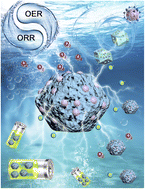Tailoring charge reconfiguration in dodecahedral Co2P@carbon nanohybrids by triple-doping engineering for promoted reversible oxygen catalysis†
Abstract
Simultaneously tuning the electronic structure of active sites and the microenvironment of the carbon matrix in metal phosphide/carbon nanohybrids is the most effective way to design and develop bi-functional electrocatalysts for electrochemically related energy storage devices. Inspired by this, a robust and advanced N/P co-doped carbon-based dodecahedron catalyst with confined Fe-doped Co2P particles was successfully prepared through a multi-doping engineering strategy. Phytic acid molecules, which were used in the synthesis of the catalyst, not only contribute to the formation of the porous structure, but also act as a phosphorus source to form the corresponding metal phosphide and the P dopant in the carbon matrix. Thanks to the unique composition and structure-dependent merits, the microenvironment of the electrocatalyst was significantly modulated, thus promoting the advantageous local charge rearrangement and smooth mass/charge transfer processes during the oxygen-related electrocatalytic reactions. As a result, the resultant catalyst exhibited significantly enhanced reversible oxygen activity, as evidenced by an ultra-small potential gap of 0.655 V (half-wave potential of 0.895 V for the oxygen reduction reaction; η10 of 320 mV for the oxygen evolution reaction), a remarkable specific capacity of 762 mA h gZn−1, and high voltaic efficiency, exceeding most previous reports. This study provides a new synthetic approach for fabricating highly efficient bi-functional oxygen catalysts and can be handily extended to the synthesis of other heterogeneous electrocatalysts for sustainable energy storage.



 Please wait while we load your content...
Please wait while we load your content...